Did you know that garlic sprouts, also known as garlic scapes, can add a delightful flavor to your dishes? Contrary to popular belief, it is actually the cloves of sprouted garlic that taste bitter, while the sprouts themselves have a herbal and grassy taste. This culinary secret is not widely known, but once you discover the unique flavor and versatility of garlic sprouts, you’ll never look at garlic the same way again.
Key Takeaways:
- Garlic sprouts have a herbal and grassy taste, while sprouted cloves taste bitter
- Garlic sprouts can be grown easily at home
- They can be used as a flavorful ingredient or garnish in various dishes
- Garlic sprouts offer health benefits and are rich in antioxidants
- Sprouted garlic cloves can be planted to grow into new garlic bulbs
Why Sprouted Garlic Tastes Different
When it comes to garlic, the taste can vary depending on its state. As garlic ages, it undergoes changes that affect its flavor profile. This is particularly noticeable when garlic cloves start to sprout.
Sprouted garlic has a distinct taste that sets it apart from its mature counterparts. The taste of sprouted garlic can be described as sharper and more fiery compared to raw cloves that haven’t sprouted.
As garlic ages, it becomes drier and loses moisture, resulting in a more intense and less sweet taste. When a clove produces a sprout, the sprout uses the sugar from the clove to grow, intensifying the flavor of the cloves.
Removing the sprouts from older garlic cloves may not make a significant difference in recipes, as the strong taste of the cloves overpowers that of the sprouts. However, if you prefer a milder garlic flavor, it’s best to use cloves that haven’t sprouted yet.
To better understand why sprouted garlic tastes different, let’s take a closer look at the factors that contribute to this unique flavor.
Factors Affecting the Taste of Sprouted Garlic
Sprouted garlic’s distinct taste can be attributed to two main factors – the aging process and the growth of the sprout.
- Aging Process: As garlic ages, it goes through chemical changes that affect its taste and aroma. The loss of moisture makes the flavor more concentrated, resulting in a stronger and less sweet taste.
- Sprout Growth: When a clove of garlic sprouts, the sprout utilizes the sugar from the clove to fuel its growth. This natural process intensifies the flavor of the cloves, giving sprouted garlic its sharper and spicier taste.
These factors work together to create the unique taste of sprouted garlic, which can be a delightful addition to certain recipes that call for a bold and fiery flavor.
Garlic sprouts can be an interesting ingredient to experiment with in the kitchen due to their distinct taste. They can add an extra layer of flavor and complexity to your dishes.
To further explore the taste of sprouted garlic, let’s consider the potential uses and culinary applications that make it a versatile ingredient to work with.
Growing Garlic Sprouts
Growing garlic sprouts is a simple and rewarding process. Not only can you enjoy the mild and refreshing flavor of these sprouts, but you can also benefit from their nutritional value. Let me guide you through the steps of growing your own garlic sprouts.
Step 1: Prepare the Garlic
To begin, separate the cloves of garlic by hand. Gently peel each clove, making sure to leave the root end intact. This root end is essential for the growth of the sprouts.
Step 2: Choose a Container
Next, find a flat-bottomed container that can hold the garlic cloves. Ensure that the container has enough space to accommodate the sprouts as they grow. Place the peeled cloves in the container with the sprouting end facing up.
Step 3: Add Water
Add enough water to the container to cover the roots of the garlic cloves. This will provide the necessary moisture for the sprouts to grow. Place the container on a windowsill where it can receive sufficient sunlight.
Step 4: Monitor and Maintain
Check the water level in the container daily and top it up as needed. It is important to keep the roots of the garlic cloves submerged in water for optimal sprouting. Within a week, you will start to see the garlic sprouts emerging from the cloves.
Step 5: Harvest and Enjoy
After about a week, the garlic sprouts will grow to be around 20cm tall and ready to be harvested. Gently cut the sprouts above the roots, leaving the roots intact for future growth. These freshly harvested garlic sprouts can be used in a variety of dishes to add a mild garlic flavor.
Benefits of Garlic Sprouts
Garlic sprouts not only enhance the taste of your meals but also offer numerous health benefits. They are rich in vitamins, minerals, and antioxidants that support your overall well-being. Incorporating garlic sprouts into your diet can boost your immune system, provide essential nutrients, and offer protection against oxidative stress and inflammation.
Growing your own garlic sprouts at home is not only cost-effective but also allows you to enjoy the freshness and flavor of these delightful sprouts. Give it a try and elevate your culinary experience with nutritious and delicious garlic sprouts!
Cooking with Garlic Sprouts
Garlic sprouts are not only a delicious addition to your meals, but they also offer numerous health benefits. Their mild garlic flavor pairs well with a variety of dishes and cuisines, making them a versatile ingredient to have in your kitchen. Whether you sauté them with vegetables, add them to omelettes or stir-fries, or use them as a substitute for spring onions, garlic sprouts can elevate the flavors of your favorite recipes.
But the benefits of cooking with garlic sprouts go beyond taste. Garlic is known for its antibacterial and antiviral properties, and those qualities extend to the sprouts as well. They are rich in antioxidants, which can help strengthen your immune system and protect against oxidative stress. Incorporating garlic sprouts into your dishes is a natural and flavorful way to boost your overall health.
“Garlic sprouts offer a fresh and mild garlic flavor that can enhance the taste of various cuisines.”
Here are some ways you can use garlic sprouts in your cooking:
- Sauté them with your favorite vegetables for a quick and healthy side dish.
- Add them to omelettes or scrambled eggs for a burst of flavor.
- Toss them into stir-fries to add a unique twist to your favorite Asian-inspired dishes.
- Use them as a substitute for spring onions in recipes for a milder garlic taste.
With their delicate texture and mild garlic flavor, garlic sprouts can enhance a wide range of dishes. They are a versatile ingredient that can add a unique twist to your favorite recipes.
To give you a better idea of the potential of garlic sprouts in cooking, let’s take a look at a simple and flavorful recipe:
Garlic Sprouts and Mushroom Pasta:
| Ingredients | Instructions |
|---|---|
| – 8 oz (225g) pasta | 1. Cook the pasta according to package instructions. Drain and set aside. |
| – 1 cup chopped garlic sprouts | 2. In a large skillet, heat olive oil over medium heat. Add the chopped garlic sprouts and sauté until tender, about 3-4 minutes. |
| – 1 cup sliced mushrooms | 3. Add the sliced mushrooms to the skillet and cook until they release their moisture and become tender, about 5 minutes. |
| – 2 cloves garlic, minced | 4. Stir in the minced garlic and cook for an additional 1 minute. |
| – 1/4 cup grated Parmesan cheese | 5. Add the cooked pasta to the skillet and toss well to combine. Sprinkle with grated Parmesan cheese. |
| – Salt and pepper to taste | 6. Season with salt and pepper to taste. Serve hot and enjoy! |
This simple pasta dish showcases the delicious and mild garlic flavor of sprouts, perfectly complementing the earthy taste of mushrooms. It’s a quick and easy recipe that can be enjoyed as a satisfying weeknight meal.
Discover the culinary possibilities that garlic sprouts offer and enjoy their unique flavor and health benefits in your cooking. Get creative, experiment with new recipes, and let the mild garlic flavor of sprouts elevate your dishes to new heights.
Health Benefits of Garlic Sprouts
Garlic sprouts are not only delicious but also incredibly nutritious, offering a wide range of health benefits. Incorporating these sprouts into your diet can contribute to your overall well-being.
Vitamins and Minerals
Garlic sprouts are rich in essential vitamins and minerals that support various bodily functions. They are particularly high in vitamins C and B6, which are important for immune health and brain function. Additionally, garlic sprouts contain minerals such as manganese, selenium, and phosphorus, which are essential for proper bone health and metabolism.
Antimicrobial Properties
One of the key compounds found in garlic sprouts is allicin, which exhibits antimicrobial properties. Allicin can help fight off harmful bacteria, viruses, and fungi in the body, supporting a healthy immune system. Including garlic sprouts in your diet may help protect you from common infections and illnesses.
Heart Health and Blood Pressure
Research suggests that garlic sprouts may have a positive impact on heart health. The allicin in garlic sprouts has been shown to help lower cholesterol levels and reduce blood pressure. By incorporating garlic sprouts into your meals, you can support a healthy cardiovascular system.
Antioxidant Power
Garlic sprouts are packed with antioxidants, which play a crucial role in combating oxidative stress and inflammation in the body. Antioxidants help protect your cells from damage caused by free radicals, reducing the risk of chronic diseases such as heart disease, cancer, and neurodegenerative disorders.
Overall, garlic sprouts are a nutritional powerhouse, offering a wide range of health benefits. From providing vitamins and minerals to supporting immune health and heart function, these sprouts are a fantastic addition to any diet.
| Nutrient | Amount per 100g |
|---|---|
| Vitamin C | 70mg |
| Vitamin B6 | 1.25mg |
| Manganese | 1.7mg |
| Selenium | 3.3µg |
| Phosphorus | 44mg |
Planting Sprouted Garlic
One of the fascinating things about garlic is that it has the remarkable ability to sprout and grow into new bulbs. If you find sprouted garlic cloves in your pantry, don’t throw them away! You can plant them in your garden and enjoy a bountiful harvest of fresh garlic. Planting sprouted garlic is a simple and rewarding process that allows you to grow your own garlic from sprouted cloves.
To start, gather the sprouted garlic cloves and carefully separate them. Peel off the papery outer layers, but make sure to leave the sprout intact. This sprout is the key to growing garlic from sprouted cloves, as it contains all the necessary nutrients and energy for the new plant.
Next, prepare your garden bed or container for planting. Garlic prefers well-amended soil that is loose and well-draining. If your soil is heavy or clay-like, consider adding compost or organic matter to improve its structure. Garlic also requires a sunny location to thrive, so choose a spot that receives at least 6 hours of direct sunlight daily.
Each sprouted garlic clove should be planted individually and spaced about 4-6 inches apart. Dig a small hole, approximately 2 inches deep, and place the clove in the hole with the sprouting end facing up. Cover the clove with soil, gently patting it down to ensure good contact.
After planting, water the garlic thoroughly to help settle the soil and provide moisture for the growing cloves. Garlic requires consistent watering, especially during dry periods, to ensure optimal growth. Aim to keep the soil evenly moist but not waterlogged.
As the garlic grows, it will form a cluster of leaves known as the garlic scape. These scapes can be harvested and used in cooking, providing a mild garlic flavor. However, if you’re aiming for larger bulbs, it’s recommended to remove the scapes to redirect the plant’s energy towards bulb formation.
With proper care and attention, your sprouted garlic cloves will grow into full bulbs ready for harvest. The time to harvest garlic varies depending on the variety and growing conditions, but it typically takes around 8-10 months from planting to maturity. Keep an eye on the leaves, and when they begin to yellow and dry out, it’s a sign that the garlic is ready for harvest.
Once harvested, you can store your garlic in a cool, dry place with good airflow to ensure it lasts for several months. With your own homegrown garlic, you’ll have a fresh and flavorful ingredient to enhance your favorite dishes!
Planting sprouted garlic allows you to harness the potential of those sprouted cloves and grow your own garlic from them. With proper planting, watering, and care, you’ll be rewarded with a bountiful harvest of deliciously fresh garlic bulbs.
Can You Eat Sprouted Garlic?
Yes, sprouted garlic is perfectly safe to eat and can be a delicious addition to your meals. Although the flavor of sprouted garlic may be milder and greener compared to cured and stored garlic, it can still be enjoyed in various dishes. The sprouts themselves have a mild flavor that can complement other ingredients and add a subtle hint of garlic to your recipes.
While sprouted garlic is safe to eat, it’s important to note that once garlic starts sprouting, it will not store well. The sprouts can continue to grow and develop, but the cloves may become soft and less flavorful over time. It’s best to use sprouted garlic promptly or consider planting it to grow more sprouts or full bulbs.
Using Sprouted Garlic in Your Recipes
When using sprouted garlic in your recipes, you can treat it like regular garlic cloves. The sprouted cloves can be chopped, minced, or crushed to release their flavor. They can be added to sauces, stir-fries, marinades, or roasted with vegetables for a hint of garlic taste. The mild flavor of sprouted garlic can be a welcome addition to dishes where a strong garlic flavor is not desired.
Alternatively, if you want to take advantage of the sprouts, you can grow them further in water. Simply place the sprouted cloves in a glass or jar filled with water, ensuring that the sprouts are partially submerged. Within a couple of weeks, the sprouts will continue to grow, resembling thin green scallion-like shoots. These garlic sprouts can be used as a garnish, added to salads, or even used as a substitute for spring onions.
| Benefits of Eating Sprouted Garlic |
|---|
| 1. Adds a mild garlic flavor to dishes |
| 2. Provides a fresh and green element to recipes |
| 3. Can be grown further to produce garlic sprouts |
| 4. Offers potential health benefits of garlic |
While sprouted garlic may have a different taste compared to cured garlic, it’s still a versatile and edible ingredient that can enhance your culinary creations. Whether you choose to use the sprouted cloves or grow the sprouts further, sprouted garlic can add a unique touch to your meals.
Caring for Spring-Planted Garlic
When it comes to spring-planted garlic, the care required is similar to that of fall-planted garlic. After planting the sprouted cloves in well-amended soil, they will begin to grow and develop roots, gradually catching up with their fall-planted counterparts. Although spring-planted garlic may experience slightly slower growth, rest assured that it will eventually yield full bulbs.
One important task in caring for spring-planted garlic is the removal of garlic scapes. These scapes are the curly flower stalks that emerge from the garlic plant. While they may look intriguing, it is crucial to remove them promptly to encourage the development of larger bulbs. By directing the plant’s energy towards bulb formation, the removal of garlic scapes helps ensure a bountiful harvest.
The journey of caring for spring-planted garlic continues throughout the spring and early summer as the plants grow and develop. Regular watering and adequate sunlight are essential for optimal growth. Keep an eye on the lower leaves of the garlic plant – when they start to dry out and turn yellow, it’s a sign that the bulbs are approaching maturity and ready to be harvested.
Benefits of Caring for Spring-Planted Garlic:
- By caring for spring-planted garlic, you ensure optimal bulb development and a successful harvest.
- Removing garlic scapes promotes larger bulb growth.
- Regular watering and sunlight support healthy plant development.
- Spring-planted garlic eventually produces full bulbs, despite initial slower growth.
I always look forward to caring for my spring-planted garlic. With proper attention and care, I know that a rewarding harvest is just around the corner.
Harvesting and Storing Garlic
When it comes to harvesting garlic, timing is key. Garlic is ready to be harvested when the lower leaves have dried out and turned yellow, typically in July or August, depending on the growing conditions.
To harvest your garlic, gently dig around the base of the plant, being careful not to damage the bulbs. Once you’ve loosened the soil, carefully lift the bulbs out of the ground. It’s important to handle the bulbs with care to avoid bruising or damaging them.
After harvesting, it’s time to focus on storing your garlic properly. Garlic needs to be stored in a cool, dry place with good airflow to prevent moisture buildup and the growth of mold or mildew. Ideally, find a spot with a temperature of around 60 to 65 degrees Fahrenheit (15 to 18 degrees Celsius) and low humidity.
One effective method for storing garlic is by braiding the stems together and hanging them in a well-ventilated area. This not only helps with the airflow but also adds an aesthetically pleasing touch to your pantry or kitchen.
If braiding isn’t your preferred method, you can also store garlic in mesh bags or woven baskets. Avoid using airtight containers, as they can trap moisture and lead to spoilage.
Properly cured garlic can last for several months, allowing you to enjoy its flavors long after the growing season has ended. However, it’s important to keep an eye on any separated garlic heads, as they tend to have a shorter shelf life than whole bulbs.
| Harvesting Tips | Storing Tips |
|---|---|
| Wait for the lower leaves to turn yellow before harvesting | Store garlic in a cool, dry place with good airflow |
| Gently dig around the base of the plant to avoid damaging the bulbs | Avoid airtight containers as they can trap moisture |
| Handle harvested bulbs with care to avoid bruising or damage | Consider braiding garlic stems for optimal storage and airflow |
By following these harvesting and storing tips, you can savor the flavors of your homegrown garlic for months to come. So go ahead, embrace the satisfaction of harvesting your own garlic and enjoy the fruits of your labor in the kitchen!
Spring-Planted Garlic vs. Fall-Planted Garlic
The main difference between spring-planted and fall-planted garlic is the timing of planting and harvest. Fall-planted garlic is planted before the soil freezes and goes through a period of dormancy during the winter. It is harvested in the summer, typically a few weeks earlier than spring-planted garlic. Spring-planted garlic, on the other hand, is planted in the spring and matures throughout the summer. While the growth may be slightly delayed compared to fall-planted garlic, both types can produce full bulbs when properly cared for.
Comparison of Spring-Planted Garlic and Fall-Planted Garlic
| Aspect | Spring-Planted Garlic | Fall-Planted Garlic |
|---|---|---|
| Planting Time | Spring | Fall |
| Harvest Time | Throughout the summer | Summer, a few weeks earlier than spring-planted garlic |
| Growth Rate | Slightly delayed | Normal growth |
| Bulb Development | Potential for full bulbs | Potential for full bulbs |
When deciding between spring-planted and fall-planted garlic, consider your specific gardening schedule and preferences. Both options can yield delicious and aromatic garlic bulbs that will enhance your culinary creations.
Conclusion
Garlic sprouts are a versatile ingredient that can enhance your cooking experience. Whether you enjoy the mild and grassy taste of sprouted garlic or want to experiment with new flavors in your recipes, garlic sprouts offer a fresh and flavorful addition to your culinary adventures.
By growing your own garlic sprouts, you have the opportunity to witness the miraculous transformation from a single clove to a flourishing sprout. It’s a rewarding process that allows you to nurture and harvest these delightful greens right in your own home. And the best part? You can enjoy the benefits of fresh garlic sprouts all year round.
When it comes to cooking, garlic sprouts can be used in a variety of dishes to add a delightful burst of flavor. Sauté them with vegetables, mix them into dips, or sprinkle them over your favorite pasta dish. The possibilities are endless! Not only do garlic sprouts offer a unique taste, but they also provide health benefits, thanks to their rich antioxidant content and immune-boosting properties.
So, why not embark on a delicious journey of growing and cooking with garlic sprouts? You’ll discover a world of culinary delights and elevate your dishes to new heights. Get creative in the kitchen and let the vibrant flavors of garlic sprouts enhance your favorite recipes. Trust me, your taste buds will thank you!

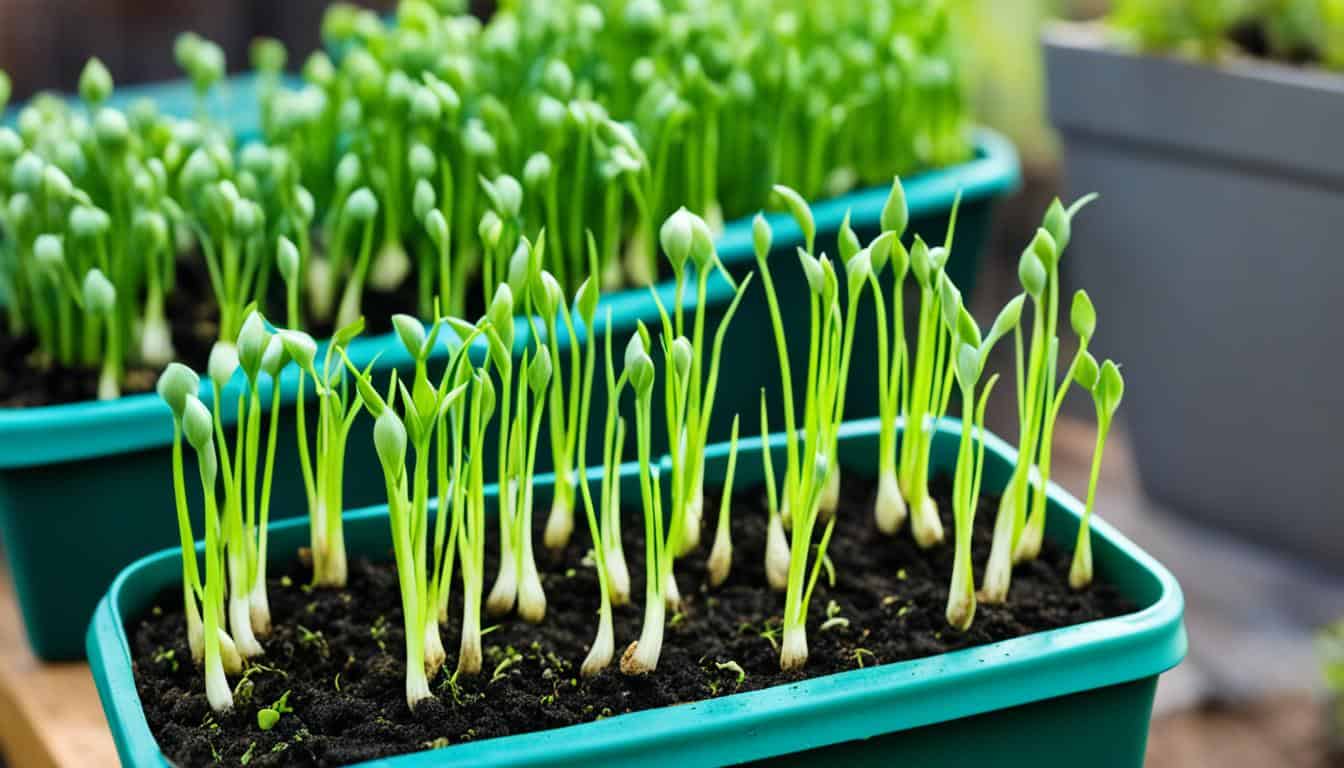
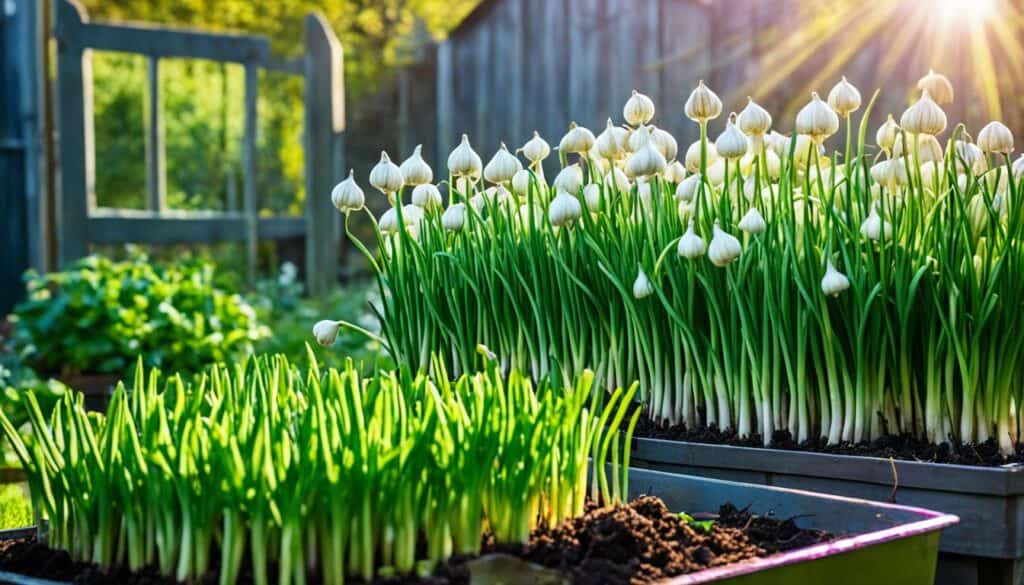
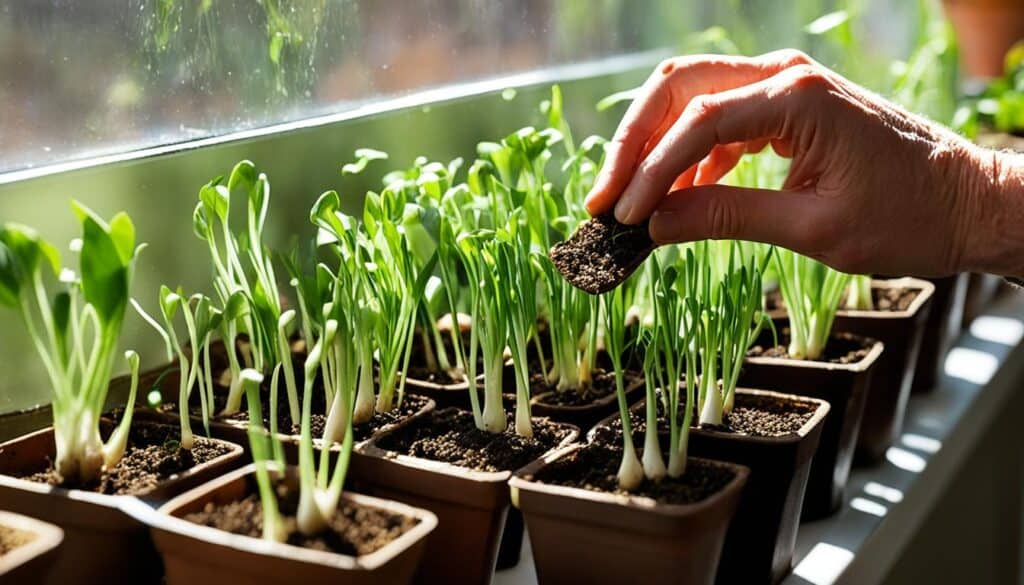
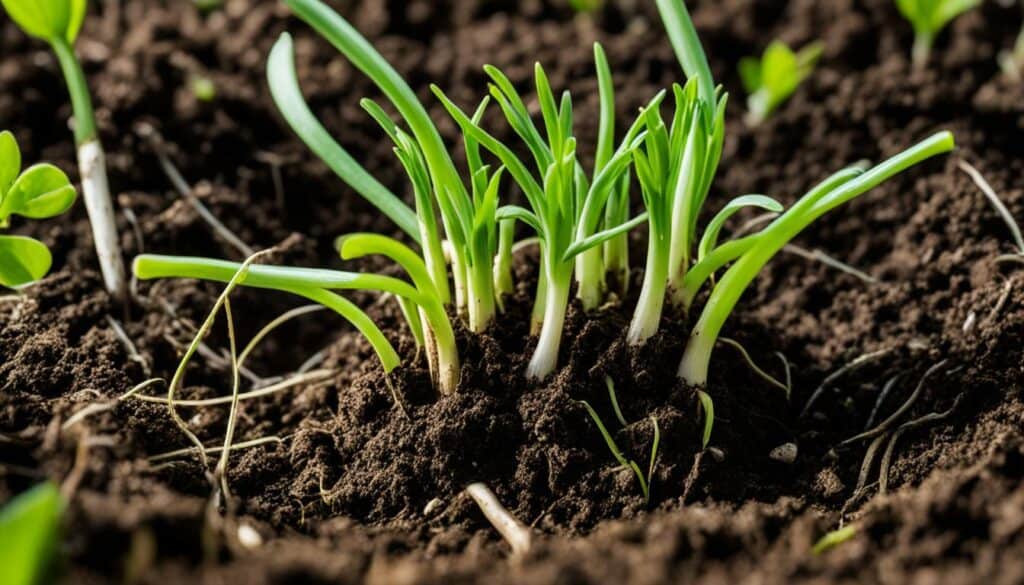
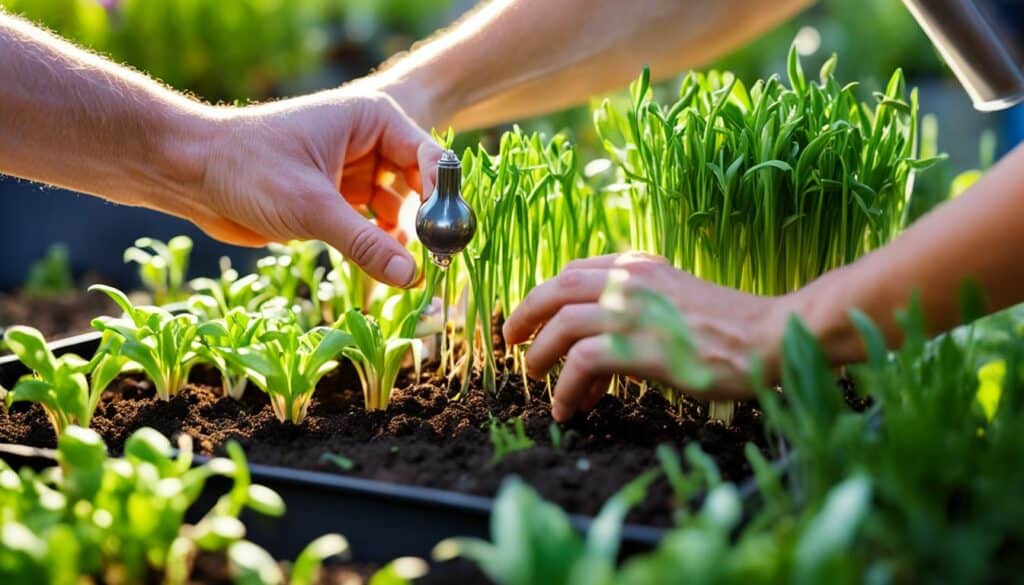
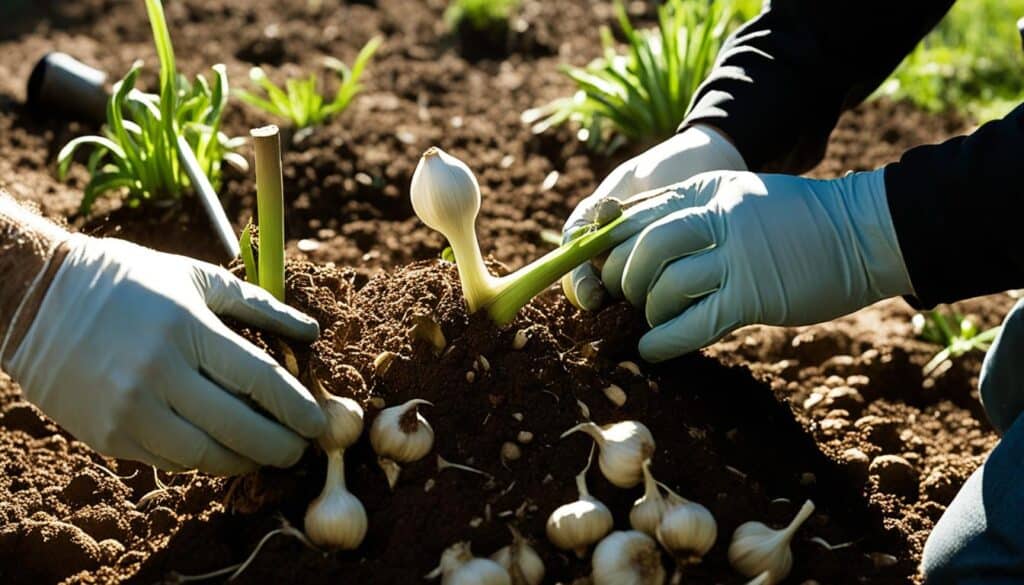



Leave a Reply